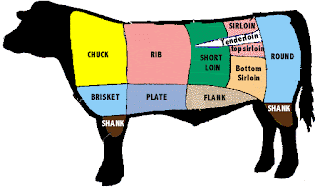Chuck Eye Steaks
In the early 1990’s my friend Sean and I would often go to San Francisco Giants games at Candlestick Park
 So what does this have to do with steak? The cow is a lot like seat prices at a baseball park. Someone in the Meat-Government complex divided up the cuts with strict lines and assigned varying quality and price levels to them. The cuts from the rib and short loin command a much higher price point than cuts from the chuck or round for good reason. A quality rib eye or porterhouse may be the greatest expression of steak but the rib/loin borders its inferiors neighbors, the round and the chuck (think
So what does this have to do with steak? The cow is a lot like seat prices at a baseball park. Someone in the Meat-Government complex divided up the cuts with strict lines and assigned varying quality and price levels to them. The cuts from the rib and short loin command a much higher price point than cuts from the chuck or round for good reason. A quality rib eye or porterhouse may be the greatest expression of steak but the rib/loin borders its inferiors neighbors, the round and the chuck (think My understanding was that the chuck eye was essentially the extension of the rib roast (i.e. rib eye). I found a couple chuck eye steaks with beautiful marbling and an overall shape similar to a rib eye. They were each about 8 oz. and were priced at $5.49/lb. For $6 I figured they were worth a try. I couldn’t make them for a few nights so I sprinkled them with kosher salt and drizzled them with olive oil, having great success with this process in the past.
The wife made a mashed potato recipe that used Yukon Gold potatoes through a food mill and lots of olive oil and I sautéed up some swiss chard. We had a bottle of Carmenere from Argentina New York
Conclusion – if you see real “chuck eye steaks” and they look well-marbled I suggest you give them a try. Season liberally, sear over high heat (pan or bbq) and finish with some slow roasting. It could be replace the Flat Iron as the hip new steak (not the new hip steak).

